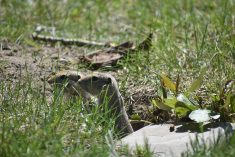A growing list of Alberta counties have declared themselves agriculture disaster areas as drought spreads across the province.
The northern counties of Sturgeon, Leduc, Mackenzie, Parkland and Thorhild and the southwestern county of Cypress are suffering from severe dryness as crops and pastures shrivel, and more could join their ranks.
Deciding to declare a disaster is a hard call to make because spotty rain has alleviated conditions for some, said Al Kemmere, president of the Alberta Association of Municipal Districts and Counties.
“Even within counties there are scorched areas and areas that are actually doing quite well.”
Read Also

Government to invest in biofuel production
The federal government will invest $370 million in a new biofuel production incentive.
The declarations are raising awareness as the situation becomes more dire.
“We don’t know if this is Year 1 of a multi-year situation or if this is going to be one year at a time,” he said.
Yields will be down and crop insurance is available, but more help may be needed.
“The province has been very clear: the insurance programs that are out there are the first line of defence,” he said.
Livestock producers are hardest hit because feed supplies are disappearing fast. The price of a bale of hay has tripled in price and is up to around $200. Hay may have to come from other regions of the country because some parts of the province are so dry there are no cereal crops for emergency grazing.
A Level 4 drought rating was declared last week for the South Coast and Lower Fraser regions of British Columbia. Local water managers could temporarily suspend short-term water approvals or water licences in affected watersheds if necessary.
A Level 3 drought rating for B.C.’s South Thompson, Nicola, Similkameen, Okanagan-Kettle and Skagit regions was also declared. Level 3 drought conditions call for voluntary water use reductions of 20 percent or more from all municipal, agricultural and industrial users.
The B.C. Cattlemen’s Association is surveying members to determine forage production, water supply and reservoir levels, regional hay availability and feed prices. The survey may be found at www.surveymonkey.com/r/BCCA_DroughtSurvey2015.
On July 23, the federal government announced 2015 tax deferrals for livestock producers in prescribed drought regions who are facing feed shortages and have to sell breeding stock. Proceeds from deferred sales are then included as part of the producer’s income in the next tax year, when those proceeds may be at least partially offset by the cost of replacing breeding animals.
The breeding herd must have been reduced by at least 15 percent. If this is the case, 30 percent of income from net sales can then be deferred.
Ninety percent of income from net sales can be deferred in cases where the herd declines by 30 percent or more. Eligible producers can request the tax deferral when filing their 2015 income tax returns.
The list of regions can be found at www.agr.gc.ca/eng?id=1437654073935.
barbara.duckworth@producer.com















